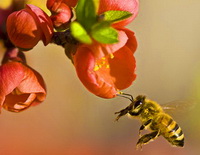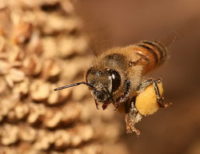Honey Bees
Fun Facts About Honey Bees & Honey
 • Bees have been producing honey for at least 150 million years
• Bees have been producing honey for at least 150 million years
• A cave painting depicting an androgynous figure robbing honey out of the hive was found in the Cave of the Spider in Valencia, Spain. It is estimated to be 15,000 years old.
• Honey stored in airtight containers never spoils. Sealed honey vats found in King Tut’s tomb still contained edible honey, despite over 2,000 years beneath the sands.
• Europeans brought the European Honeybee to America in 1638. The Native Americans referred to the honeybee as the “White Man’s Flies,” because wild swarms always preceded the arrival of the white man.
• 80% of the pollination of the fruits, vegetables and seed crops in the U.S. is accomplished by honeybees.
• Honey bees have five eyes
• A queen is the largest bee in the hive. She can lay up to 2,000 eggs per day, twice her own body weight per day. The queen mates with 10 to 20 males before she returns to the hive to bear her progeny.
• Drones have no stinger. They do no real work. Their only purpose is to mate with virgin queens. Drones die after mating, as as his abdomen rips open when his endophallus is riped off by the Queen.

• Bees must visit approximately 2 million flowers and have to fly over 55,000 miles to make 1 lb. of honey.
• On average a worker bee will make 1/12 teaspoon of honey in her lifetime.
• Two tablespoons of honey would fuel a honey bee flying once around the world.
• Honey bees will visit between 50-100 flowers during one nectar collection trip.
• When old bees have worked almost an entire season, their wings become frayed and warren. They cannot fly. Younger bees then turn these older hands out either pushing them out of the entrance or carrying them into the air and dropping them ½ mile or more away. They cannot fly or walk back, so they die. This law of survival of the fittest applies to young bees with defective legs or wings and also to Queens. When a queen fails to lay eggs in sufficient numbers and to take care of the needs of the hive, a new queen is raised, and the old one is eliminated.
